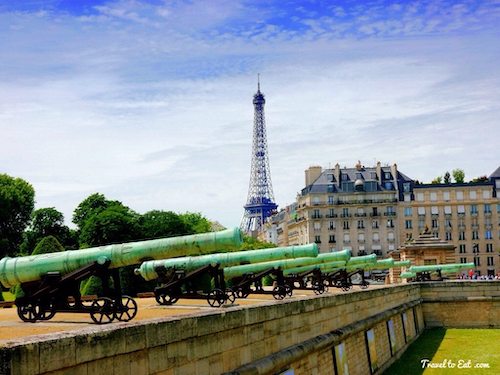
One of the first things you notice when you approach Les Invalides is the row of cannons facing outward across a small moat. These are not little cannons, they are for the most part giant beasts requiring iron trolleys just to stay in place. These pieces are part of the Musée de l'Artillerie (Museum of Artillery, founded in 1785 in the aftermath of the French Revolution and expanded under Napoleon). It was moved into the Hôtel des Invalides in 1871, immediately following the Franco-Prussian War and the proclamation of the Third Republic. The collection was augmented by collections from the National Library, the Louvre, the Artillery of Vincennes, the Hôtel des Monnaies and many private collections. Another institution called the Musée Historique de l'Armée (Historical Museum of the Army) was created in 1896 following the World Fair. The two were merged in 1905 into the Musée de l'Armee.
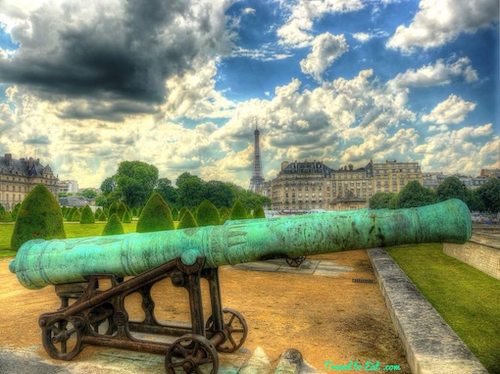
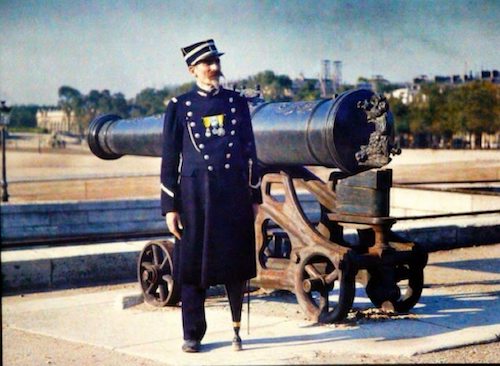
The cannon are not just for show, the cannon form the Triumphal Battery of the Hôtel. By tradition, going all the way back to the founding of Invalides, the cannon were served by the resident injured soldiers and were discharged during Parisian celebrations. The ceremonial battery was removed at the time of the revolution but reassembled in 1804 at the request of Marshal Sérurier, Marshal of the Invalides. The pieces on display this year are all trophy cannon, captured from the enemy, 16 from the Ottoman Empire and four from China and two from Prussia. The picture shown above from 1918 is from. Mr Kahn, a French millionaire banker and philanthropist, undertook an ambitious project in 1909 to create a vast photographic collection. His legacy of more than 72,000 photographs, including the early shots of his beloved Paris, are now available for people to view at the Albert Kahn Museum on the grounds of his estate in Paris. Kahn's photographs were the basis of a ten-part BBC documentary “The Wonderful World of Albert Kahn” released in 2009.
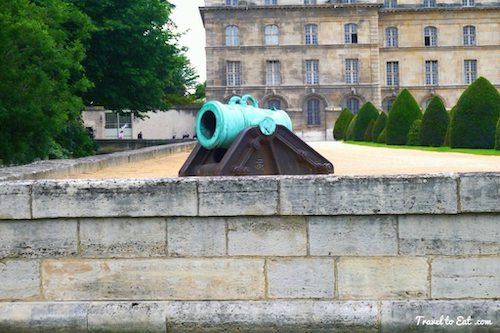
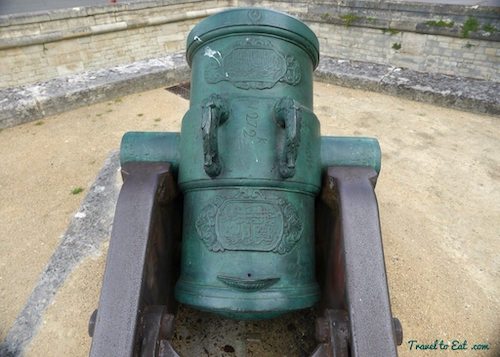
This includes a Turkish howitzer obviously captured somewhere. The Mortar was a German invention in the mid 1500's, a thick-walled, short-barrelled gun that blasted shot upward at a steep angle. Mortars were useful for sieges, as they could hit targets behind walls or other defenses. A howitzer is in between a mortar shooting at a high trajectory and a gun firing a flat trajectory. I am calling this a howitzer because it has an adjustable angle of fire, the firing pan looks like it was always set for a high trajectory.
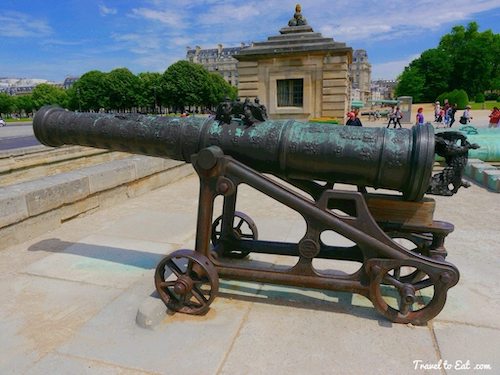
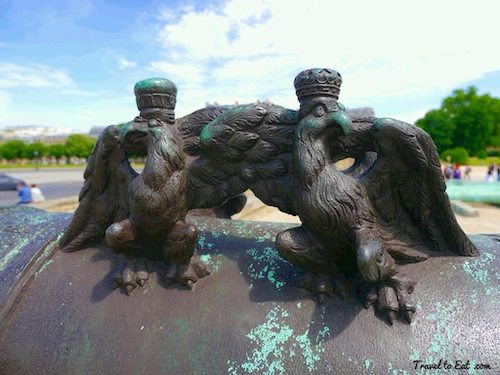
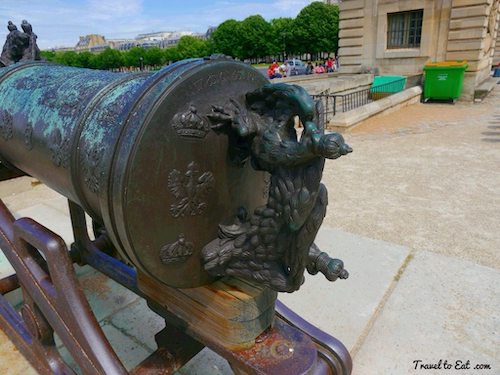
They have two examples of this beautiful Prussian cannon out front from around 1700 by Johann Jacobi. Johann Jacobi (1661-1726) was a German art founder and close collaborator of Andreas Schlüter. In 1693 we find John Jacobi in Paris in the service of the brothers Johann Jakob (1635-1700) and Johann Balthasar Keller (the founder of the first large French cannon) (1638-1702). In 1695 Jacobi went to Berlin. Whether this was done at the instigation of his friend Schlüter has not been clarified. In 1697 he received a contract from Elector Frederick III (first King in Prussia Frederick I) as a “yard and artillery foundry”. Jacobi undertook the contract to deliver ten cannons or mortars a month for which he received an annual salary of 1,000 guilders. This cannon is part of that original contract and the sculptures of the Royal Eagles are really amazing.
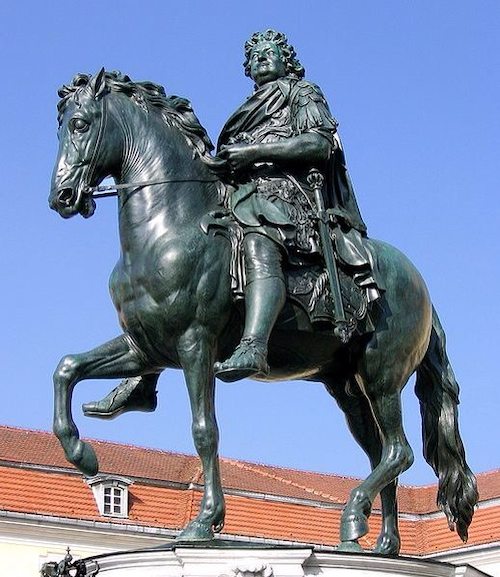
Johann Jacobi's most famous art casting work is the famous equestrian statue of the Great Elector from 1700, the model was made by Schlüter. In return for aiding Emperor Leopold I during the War of the Spanish Succession, Frederick William's son, Frederick III, was allowed to elevate Prussia to the status of a kingdom. On 18 January 1701, Frederick crowned himself Frederick I, King in Prussia. Prussia, unlike Brandenburg, lay outside the Holy Roman Empire, within which only the emperor and the ruler of Bohemia could call themselves king. As king was a more prestigious title than prince-elector of the Holy Roman Emperor, the territories of the Hohenzollerns became known as the Kingdom of Prussia, although their power base remained in Brandenburg.

From 1701 to 1946, Brandenburg's history was largely that of the state of Prussia, which established itself as a major power in Europe during the 18th century. King Frederick William I of Prussia, the “Soldier-King”, modernized the Prussian Army, while his son Frederick the Great achieved glory and infamy with the Silesian Wars and Partitions of Poland. The feudal designation of the Margraviate of Brandenburg ended with the dissolution of the Holy Roman Empire in 1806, which made the Hohenzollerns de facto sovereigns over it. Brandenburg, along with the rest of Prussia, became part of the German Empire in 1871 during the Prussian-led unification of Germany, which eventually led to the first and second world wars. These cannon have real stories to tell, if anyone is listening.
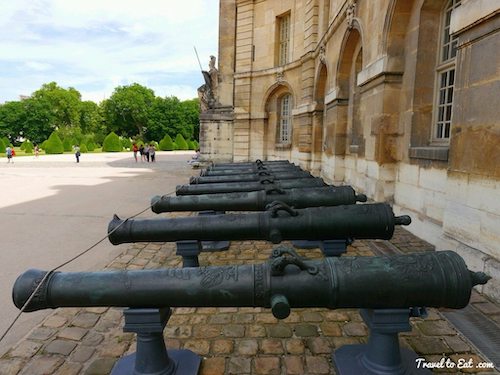
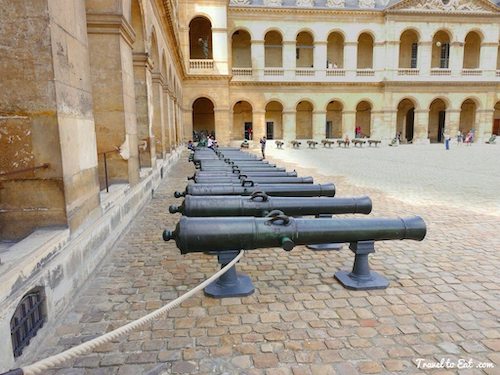
In addition to the cannon in front of Les Invalides, they have a collection displayed in front of the entrance on each side and in the Court of Honor, 60 in all though I did not count. They are all cast from bronze, bronze is more flexible than iron and therefore less prone to bursting when exposed to high pressure. Cast iron cannon are less expensive and more durable generally than bronze and withstand being fired more times without deteriorating. However, cast iron cannon have a tendency to burst without having shown any previous weakness or wear, and this makes them more dangerous to operate. The ones around the entrance are smooth bore cannon from the era of De Vallière (1732-1760's), the ones in the courtyard have mostly been re-cut with spiral rifling.
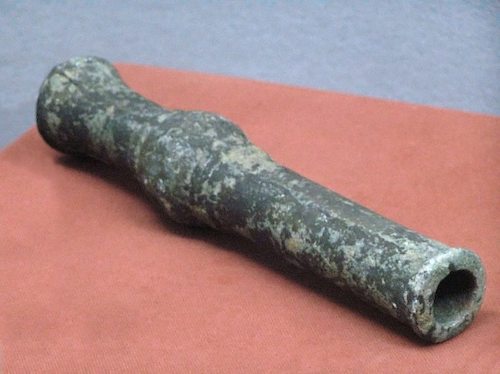
The invention of the cannon, driven by gunpowder, was first developed in China. Like small arms, cannon are a descendant of the fire lance, a gunpowder-filled tube attached to the end of a spear and used as a flamethrower in China. Shrapnel was sometimes placed in the barrel, so that it would fly out along with the flames. The weapon was later taken up by both the Mongol conquerors and the Koreans. Chinese soldiers fighting under the Mongols appear to have used hand cannon in Manchurian battles during 1288, a date deduced from archaeological findings at battle sites. The Ming Chinese also mounted over 3,000 cast bronze and iron cannon on the Great Wall of China, to defend against the Mongols.
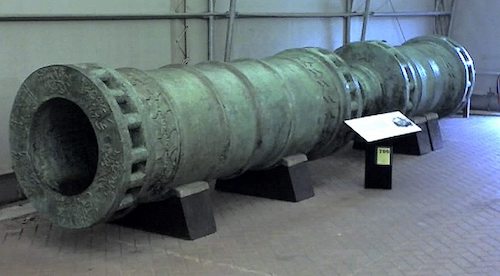
The 14th century saw a considerable development of the new weapons in France and in Western Europe in general, especially with the outbreak of the Hundred Years' War (1337–1453). Until 1370, cannons were essentially small weapons of 10 to 20 kg (20 to 40 lbs), made of brass or copper. By the middle 1400's the little popguns that tossed one or two pound pellets had grown into enormous bombards. The first definite use of artillery in the region was against the Ottoman siege of Constantinople, in 1396, forcing the Ottomans to withdraw. They acquired their own cannon, and laid siege to the Byzantine capital again, in 1422, using “falcons”, which were short but wide cannon. By 1453, the Ottomans used 68 Hungarian-made cannon for the 55-day bombardment of the walls of Constantinople, “hurling the pieces everywhere and killing those who happened to be nearby.” The largest of their cannon was the Great Turkish Bombard, which required an operating crew of 200 men and 70 oxen, and 10,000 men to transport it.
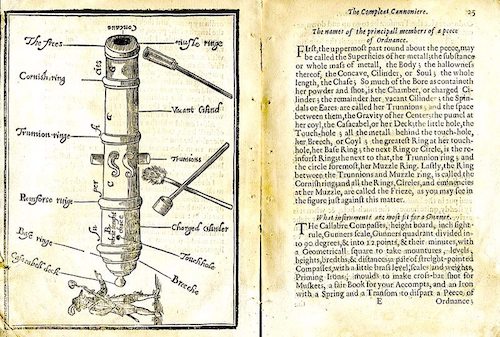
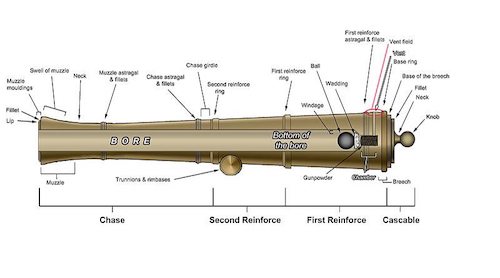
After 1470 the art of casting greatly improved in Europe. Lighter cannon began to replace the bombards. Throughout the 1500's improvement was mainly toward lightening the enormous weights of guns and projectiles, as well as finding better ways to move the artillery. Thus, by 1556 Emperor Ferdinand I was able to march against the Turks with 57 heavy and 127 light pieces of ordnance. By the 16th century, cannon were made in a great variety of lengths and bore diameters, but the general rule was that the longer the barrel, the longer the range. By mid-century, European monarchs began to classify cannon to reduce the confusion. Henry II of France opted for six sizes of cannon. The casting of trunnions on the gun made elevation and transportation easier, and the cumbrous beds of the early days gave way to crude artillery carriages with trails and wheels.
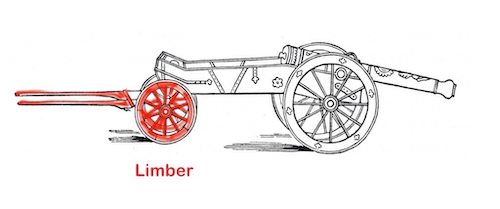
The French invented the limber and about 1550 took a sizable forward step by standardizing the calibers of their artillery. Using light guns, hauled by the best of horses instead of the usual oxen, the French further improved field artillery, and maneuverable French guns proved to be an excellent means for breaking up heavy masses of pikemen in the Italian campaigns of the early 1500's. A limber is a two-wheeled cart designed to support the trail of an artillery piece, or the stock of a field carriage such as a caisson or traveling forge, allowing it to be towed. A caisson is a two-wheeled cart designed to carry artillery ammunition.
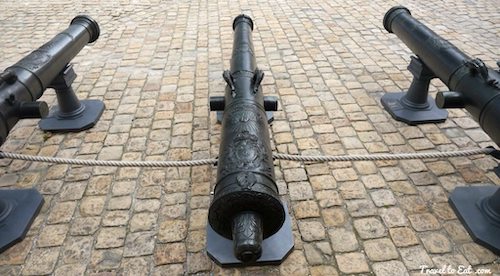

Jean-Jacques Keller (1635–1700) and his brother Jean-Balthazar Keller (1638–1702) were Swiss gunfounders from Zürich, in the service of France. Their first models of cannons, which were developed by the Keller brothers in 1666 were used in sieges against fortified towns during the wars of Louis XIV and made the successes of Vauban possible. The technology they employed, involving the founding of cannons around a plaster core, was superseded by the De Vallière system in 1732. The cannon pictured above is a Keller 12 pounder Le Solide. As big as these cannon seem, they were much smaller than their predecessors. These cannon were also valuable, note the grinding down of the decorations to add a sight at a later time on the 24 pounder Le Combatant.
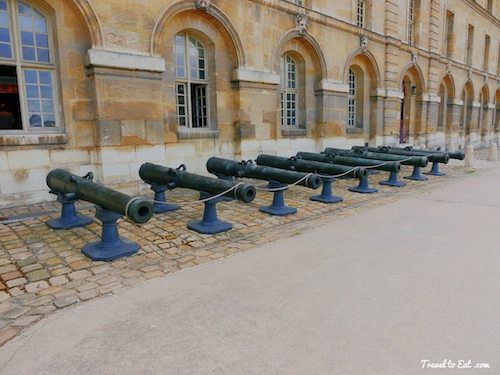
Louis XIV of France seems to have been the first to give permanent organization to the artillery. He raised a regiment of artillerymen in 1671 and established schools of instruction. The “standing army” principle that began about 1500 was by now in general use, and small armies of highly trained professional soldiers formed a class distinct from the rest of the population.
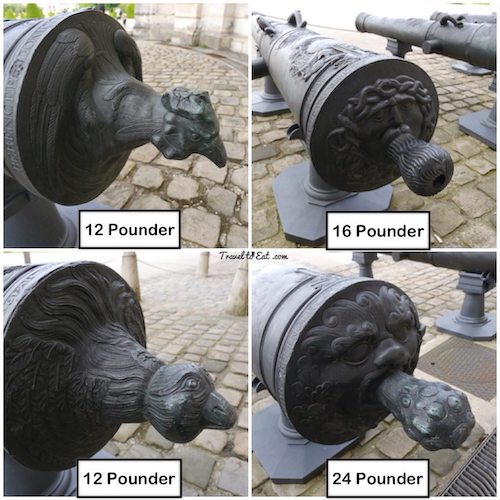
Whereas numerous formats and designs had previously been in place in the French army, starting in 1732 Jean-Florent de Vallière standardized the French sizes in artillery pieces, by allowing only for the production of 24 (Bacchus head in the back), 16 (Medussa head in the back), 12 (Rooster or Bird head in the back), 8 and 4 pound guns (the weight is the weight of the cannon balls) and mortars of 12 and 8 French inches. The guns had cascabel designs which allowed to easily recognize their rating: a 4-pounder would have a “Face in a sunburst”, an 8-pounder a “Monkey head”, a 12-pounder a “Rooster head”, a 16-pounder a “Medusa head”, and a 24-pounder a “Bacchus head” or a “Lion head”. The de Vallière system used core drilling of the bore of cannons founded in one piece of bronze, a method developed at that time by Jean Maritz, which allowed for much higher precision of the bore shape and surface, and therefore higher shooting efficiency.
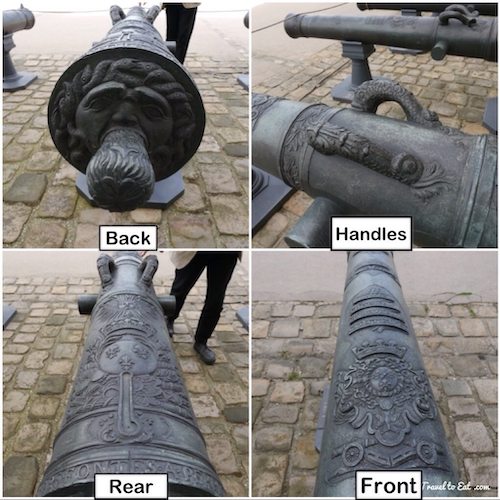
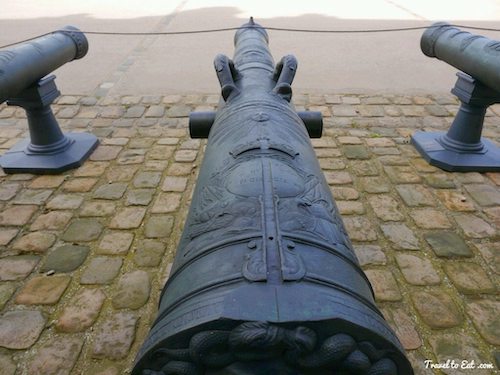

The de Valliere guns were also highly decorative and contained numerous designs and inscriptions. Even though the core drilling technique was developed by Jean Maritz and he made the majority of the cannon in the collection from this time period, cannon were produced by other foundries as shown above.
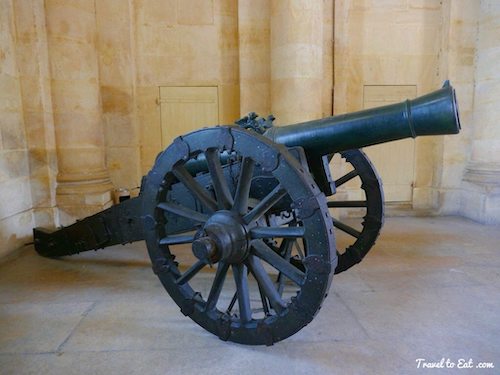
In the early 18th century the Russian army began equipping cavalry formations with small units of light horse artillery equipped with 2-pound cannons, and portable 3-pound mortars which were transported on horseback (the weights refer to the size of the projectiles, not the artillery pieces.) Though not decisive by themselves, these units inflicted losses on Prussian troops and influenced Frederick the Great to form the first regular horse artillery unit in 1759. Frederick sent his 3 and 6-pounders ahead of the infantry. Gunners dismounted 500 paces from the enemy and advanced on foot, pushing their guns ahead of them, firing incessantly and using grape shot during the latter part of their advance. Up to closest range they went, until the infantry caught up, passed through the artillery line, and stormed the enemy position. The cannon shown above is a Prussian 12 pounder from about 1780 after the reforms and adoption of the horse cavalry.

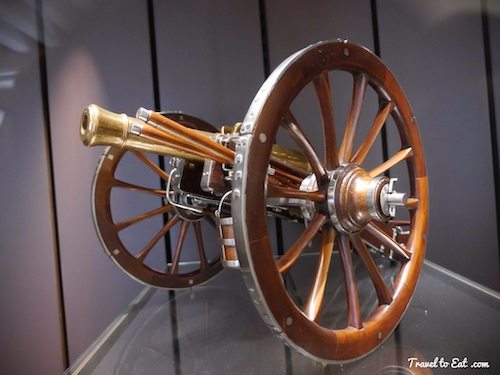
Jean Baptiste Gribeauval had served with the military mission to Prussia, as well as fighting against Frederick in the Seven Years' War. Beginning in the late 1760s, the artillery used by the French Army was completely redesigned along scientific principles by Grimbeauval, who standardized all construction and design and became Inspector General of Artillery in 1776. This resulted in lighter, more manageable cannon and better quality barrels and ammunition. Gribeauval reworked the hardware to give it more strength, mobility and consistency and achieve greater speed and greater accuracy shooting. He reduced the length and weight of the pieces, as well as the charge and the windage (the difference between the diameters of shot and bore); he built carriages so that many parts were interchangeable, and made soldiers out of the drivers. The idea on which is based its entire organization is the establishment of a separate hardware for each service campaign, siege, space and coast. Following the commission of Strasbourg (1764), it was decided to limit the guns to campaign templates 12, 8 and 4 pounds. Parts 16 and 24 now owned siege artillery. As pointed out in the figures, the result of the reforms was that French artillery weighed about half of equivalent Prussian artillery thus setting the stage for Napoleon's stunning successes. By 1795 the French horse artillary had grown to eight regiments of six six-gun batteries each, making it the largest horse artillery force ever assembled.
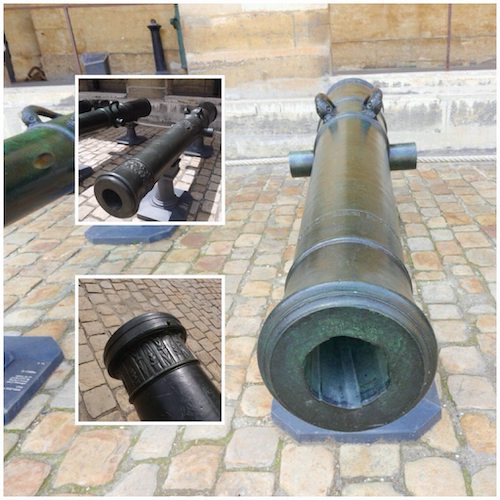
The cannon of the late 1600's was an ornate masterpiece of the foundryman's art, covered with escutcheons, floral relief, scrolls, and heavy moldings, the most characteristic of which was perhaps the banded muzzle, that bulbous bit of ornamentation which had been popular with designers since the days of the bombards. The flared or bell-shaped muzzle did not supplant the banded muzzle until the eighteenth century, and, while the flaring bell is a usual characteristic of ordnance founded between 1730 and 1830, some banded-muzzle guns were made as late as 1746.
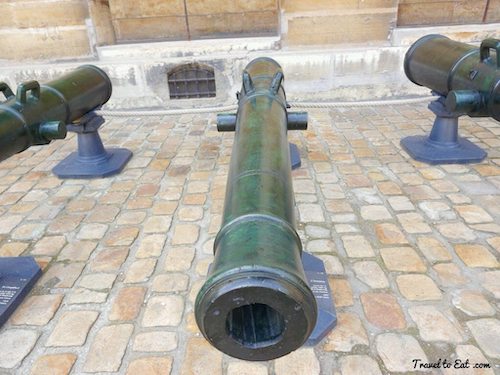
By 1750, however, design and construction were fairly well standardized in a gun of much cleaner line than the cannon of 1650. Although as yet there had been no sharp break with the older traditions, the shape and weight of the cannon in relation to the stresses of firing were becoming increasingly important to the men who did the designing.
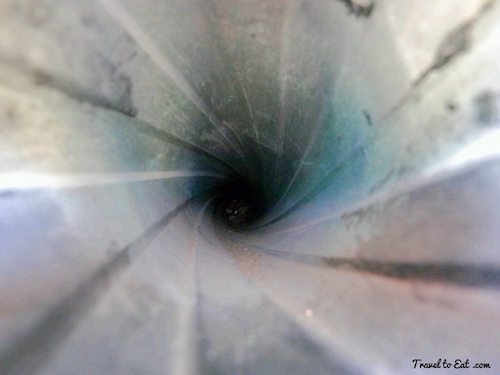
Barrel rifling was invented in Augsburg, Germany at the end of the fifteenth century. In 1520 August Kotter, an armourer of Nuremberg, Germany improved upon this work. Though true rifling dates from the mid-16th century, it did not become commonplace until the nineteenth century. Rifling is the process of making helical grooves in the barrel of a gun or firearm, which imparts a spin to a projectile around its long axis. This spin serves to gyroscopically stabilize the projectile, improving its aerodynamic stability and accuracy. If you notice, the last two cannon have had rifling added in the 19th century, a common practice at the time.
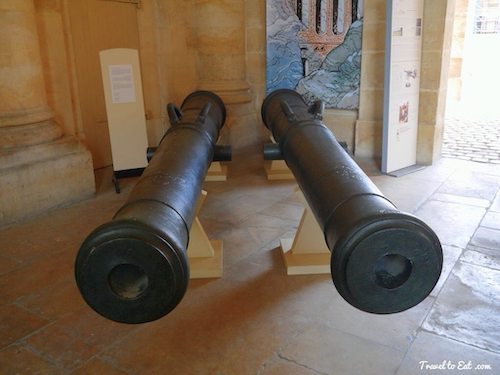
These guns were on the Algiers city walls in 1830. These bronze guns fired 12-kg iron shot. They were cast in 1775 in Algiers by François Dupont. He was a French gunmaker whom MuDammad Bâsâ bin UDmân, Dey of Algiers, called to his court in 1774 , with the King of France's approval, to produce powerful artillery able to protect the city of Algiers. The guns defended the city against the Spanish expeditions of 1775, 1783, 1784 and 1814 but could not prevent the bombardment by the French in 1830.
References:
Musée de l'Armee: http://www.musee-armee.fr/en/english-version.html
Model of a 1764 12 lb. http://onesixthhobby.over-blog.com/article-34110608.html
Artillery Through the Ages: http://www.nps.gov/history/history/online_books/source/is3/is3toc.htm
Cannons of the 18th Century: http://www.thepirateking.com/historical/cannon_eighteenth_century.htm
Paris 1914: http://www.dailymail.co.uk/news/article-2236989/Photographs-Paris-1914-taken-collection-Albert-Khan-Museum-Paris.html

